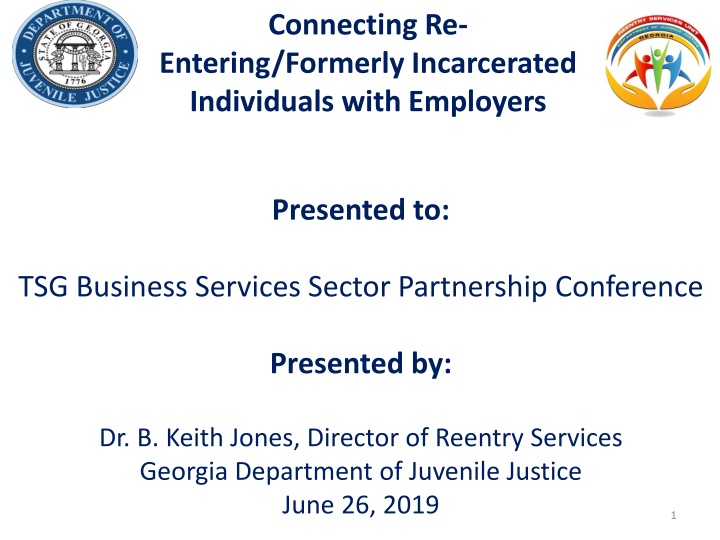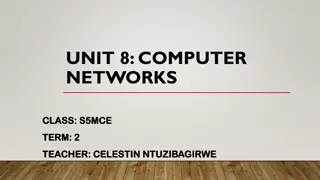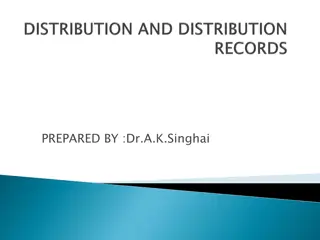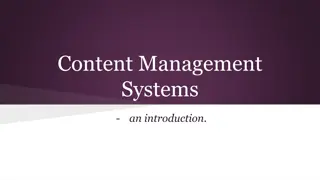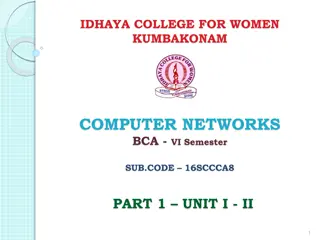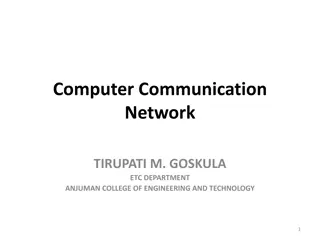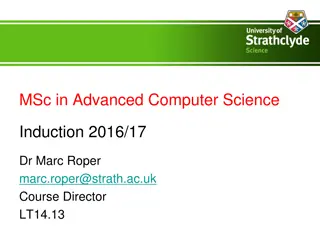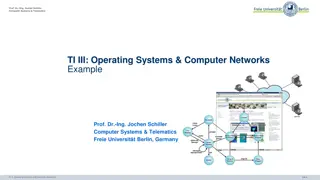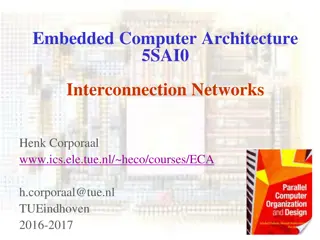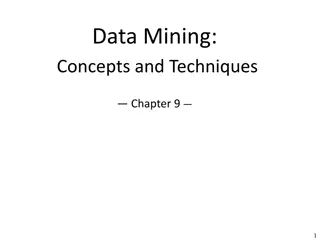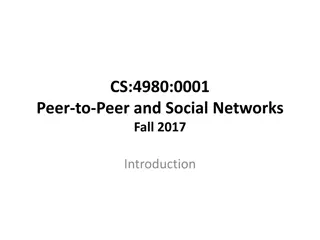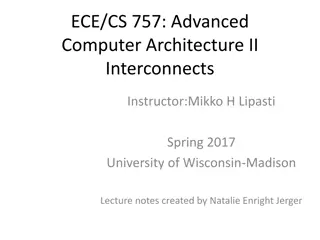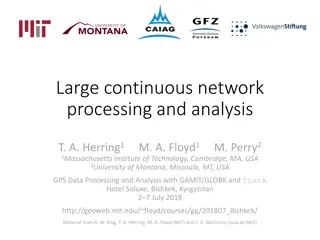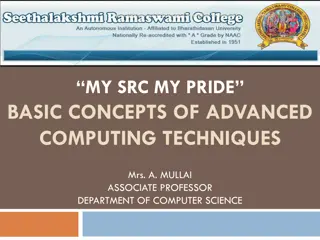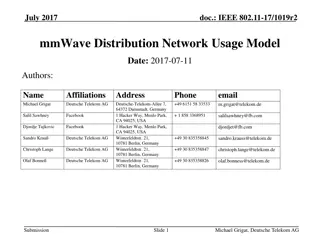Advanced Computer Systems Lecture 16 - Content Distribution Networks
This lecture delves into Content Distribution Networks (CDNs) and their significance in optimizing web content delivery. Topics covered include issues with single servers, skewed traffic distribution, web caching, proxy caches, and limitations of caching. The lecture also explores the role of forward and reverse proxies in enhancing web performance and reducing server loads, with insights from Google's data center design.
Download Presentation

Please find below an Image/Link to download the presentation.
The content on the website is provided AS IS for your information and personal use only. It may not be sold, licensed, or shared on other websites without obtaining consent from the author.If you encounter any issues during the download, it is possible that the publisher has removed the file from their server.
You are allowed to download the files provided on this website for personal or commercial use, subject to the condition that they are used lawfully. All files are the property of their respective owners.
The content on the website is provided AS IS for your information and personal use only. It may not be sold, licensed, or shared on other websites without obtaining consent from the author.
E N D
Presentation Transcript
Connecting Re- Entering/Formerly Incarcerated Individuals with Employers Presented to: TSG Business Services Sector Partnership Conference Presented by: Dr. B. Keith Jones, Director of Reentry Services Georgia Department of Juvenile Justice June 26, 2019 1
BUILDING AND SUSTAINING AN EFFECTIVE REENTRY TASK FORCE Agenda Juvenile Justice Reform in Georgia Strategic Framework Reentry Task Force Collective Impact Framework Partnerships 2
GA Juvenile Justice Reform Legislative Priorities Established Governor and Legislators Collaboration Georgia passed sweeping reforms that started in 2011 Created the GOTSR - Governor's Office of Transition Support and Reentry by executive order House Bill 349, signed into law by Governor Deal in 2013, created the 15-member Georgia Council on Criminal Justice Reform (the Council) with a five-year mandate to promote public safety through better oversight and management of the adult and juvenile correctional systems. With evidence-based practices (EBP), we will affect the lives of the youth under our supervision. 3
GA Juvenile Justice Reform The Special Council on Criminal Justice Reform Extensive Review of Data Obtained Technical Assistance o The Pew Charitable Trusts o Annie E. Casey Foundation o Crime & Justice Institute 2013 Pew report on Georgia DJJ key findings o $300 million dollar budget o Nearly 2/3 spent on out of home facilities o $91,000 per bed (YDCS) & $88,000 per bed (RYDCS) o Recidivism over 50% o Lack of access to proven programs o Low risk youth in facilities (53%) o Limited options for judges Georgia s 2013 Juvenile Justice Reform 4
DEVELOPMENT OF THE STRATEGIC FRAMEWORK 2014 In December 2013, the Department of Juvenile Justice launched the development of the Strategic Framework by: Mirrored the GA-PRI Framework and converted it into juvenile justice language Assigned representatives to participate in a Reentry Oversight Committee (ROC) from all sections within the Department Developed the Strategic Framework by engaging an extensive range of subject matter experts in workgroup meetings co-facilitated based on the subject area of discussion Workgroup met weekly over a three month period discussing the GA- PRISeven Decision Points and twenty-seven Targets for Change The Reentry Strategic Framework initiated a process of continuous strategic thinking and planning that produced a framework for implementation 5
Operationalizing Task Force Work in Georgia DJJ Strategic Plan published September 2014 o Total Barriers Resolved 38 of 40 o Internal - 19 of 19 o External 19 of 21 Total Barriers Phase I o Internal - 3 of 3 o External - 1 of 1 Total Barriers Phase II o Internal - 5 of 5 o External - 16 of 17 Total Barriers Phase III o Internal - 11 of 11 o Eternal - 2 of 3 Note: Internal Barriers are those things for which change can be facilitated by DJJ unilaterally while External Barriers are those things that require the collective engagement of the task force.
IMPLEMENTING THE STRATEGIC FRAMEWORK Task Force Development 7
DJJs Process Development of a Strategic Plan o Three Phases o Seven Decision Points o Twenty Seven Targets for Change Identify Members o State Agencies o Private Agencies o Youth Advocates o Religious/Civic Organization o Businesses & Business Leaders Recruitment Word of Mouth Mailing/Emailing lists Attend meetings o Conferences o Coalitions o Staff meetings o Board meetings 8
Reentry Task Force Employment of Collective Impact Five components identified in research by Stanford Social Innovation Review 1. Common Agenda 2. Shared measurement 3. Mutually reinforcing activities 4. Continuous Communication 5. Backbone Support
Reentry Task Force Goals Continue Juvenile Reentry task force work indefinitely creating: o Increased collaborative grant opportunities o Integrated system of care for youth returning home from custody o Strengthen families and communities o Drive down recidivism in DJJ and decrease adult offender population o Cultivate a culture of Hope and Youth Change o Develop policy First Meeting March 2015 (50+ attendees) Current Members o The task force consists of 70 member organizations which include partners from state agencies and private organizations o The Governance Council consists of members appointed by the Director of Reentry Services
Reentry Task Force Current Structure Divided by Subgroups based on the Domains of Aftercare and organizational strengths: o Family and Living Arrangements o Peer Groups and Friends o Physical, Behavioral Health, and Substance Abuse o Education, Vocational Training and Employment o Leisure Time, Recreation and Avocational Interests o Parenthood Project Subgroup meetings monthly; Task Force meetings quarterly Governance Council o Members appointed by ORS Director o Operational oversight o Training o Policy development
Reentry Task Force Most Recent Task Force Audit 42% of the task force organizations attended 11 or more task force meetings 81% have been members for more than 12 months 54% have provided more than 10 services to DJJ youth 62% have capacity to provide services statewide 76% organizations size is more than 10 employees
Task Force Collaborations Georgia Vocational Rehabilitation Agency o Pilot at Augusta YDC o Job Readiness Classes - taught by Easter Seals o Work-Based Learning (WBL)- minimum wage for youth hours spent on details, "hands-on" skills o Extensive youth psycho-social evals on-site to determine youth needs regarding employment o February 2018 May 2019: 79 youth have participated earning $7.25/hour; 14+yo eligible o WBL 43 participated; 18 have been released, earning from $73 to $3903; 3 youth remaining have earned $3719, $3770, $4954 13
Task Force Collaborations (Cont.) Jobs for Georgia Graduates/DOL Piloted at Macon YDC, model to be spread to other YDCs and nationally by the company Generic Job Readiness classes taught by AT&T staff (applicable to any employment, not just AT&T) AT&T job certifications, pathways to employment, and tech school credit for participants Uniforms, field trips, other immersion activities Target date for expansion January 2020 at Eastman YDC 14
Task Force Collaborations (Cont.) CodeOut Piloted at Macon YDC for detained females CodeOut is a non-profit organization is supported by businesses needing coders Youth who finish the program receive industry- recognized certification are expected to receive a job earning a minimum of $50K or more The youth recently completed a field trip to Turner Broadcasting and Mail Chimp 15
Task Force Collaborations (Cont.) Home Depot Pilot complete at Atlanta YDC Generic Job Readiness classes taught by Home Depot staff (applicable to any employment, not just Home Depot) Field trips planned to various types of Home Depot sites Special consideration for Home Depot employment to be given to graduates First class graduated8 youth Statewide rollout underway 16
Task Force Partnerships (Cont.) Technical College System of Georgia oTech school credit for Job Readiness, other classes oConsideration of collaboration with DJJ due to TCSG merging with WIOA Wal-Mart oYouth referrals from DJJ to Wal-Mart job fairs will receive special consideration
Task Force Partnerships (Cont.) Movement to Success o Piloted at Augusta YDC o Lawyers teach debating/self-advocacy skills o Plans to expand statewide Future partners under various stages of consideration o Masonry- business owner ready to teach youth in a facility; looking for appropriate location o Apprenticeships in building & construction trades- pre-apprenticeship being offered to youth free of charge; certification will give them leg up; looking to implement at Augusta YDC
Technology Updates Resource Database Components: Deployed with approximately 1,000 resources and as of June, has nearly 2800 resources RRCs can document and update resources immediately via cell phone, tablet, or computer High level resource summaries/graphs are available oTracking of web hits by county, district, and region oResources by county, district, and region 19
B. Keith Jones, PhD Director of Reentry Services Georgia Dept. of Juvenile Justice Desk: 229-336-2369 Office Main: 229-522-3682 Cell: 404-859-0811 Fax: 404-478-7960 Email: keithjones@djj.state.ga.us
